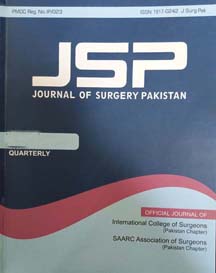Clinical Presentation and Management of Congenital Inguinal Hernia and Hydrocele In Children
Shumaila Israr
Abstract
Objective
To evaluate the age, gender, laterality of the lesions, surgical treatment provided and complications of congenital inguinal hernia and hydrocele surgery in children.
Study design
Descriptive case series.
Place & Duration of study
Department of Pediatric Surgery, Lyari General Hospital Karachi, from July 2023 to June 2024.
Methods
Data regarding age, gender, diagnosis, procedure performed, morbidity and mortality rate were recorded of all the patients of inguinal hernia and hydrocele who were managed as elective cases during the study period. Patients with associated anomalies were not enrolled. All procedures were performed under general anesthesia. Minimal invasive approach was not employed. Data were entered into analyzed using SPSS version 22. Descriptive statistics were used to present the data.
Results
A total of 105 patients were included in the study. There were 92 (87.6%) male and 13 (12.4%) female patients. Of the total 79 (75.2%) patients had inguinal hernias. In this category there were 66 male children. Twenty-two (21.0%) male patients had scrotal hydrocele while 4 (3.8%) had hydrocele of the cord. The most common presenting age group was between 5-10 years. Complication were noted in 5 (4.6%) patients following surgery; three had superficial wound infection and two developed residual scrotal edema. No recurrence was noted at follow up. In this series two children presented with metachronous hernia and operated.
Conclusion
Inguinal hernia and hydrocele were common congenital conditions in children. However, most common age at presentation was between 5 – 10 years. Open surgical approach for inguinal hernia was found safe with minimal postoperative complication.
Key words
Hernia, Hydrocele, Hydrocele of cord, Child. Congenital anomaly.

